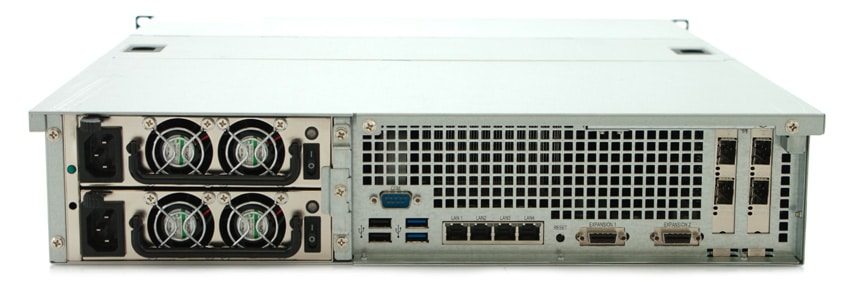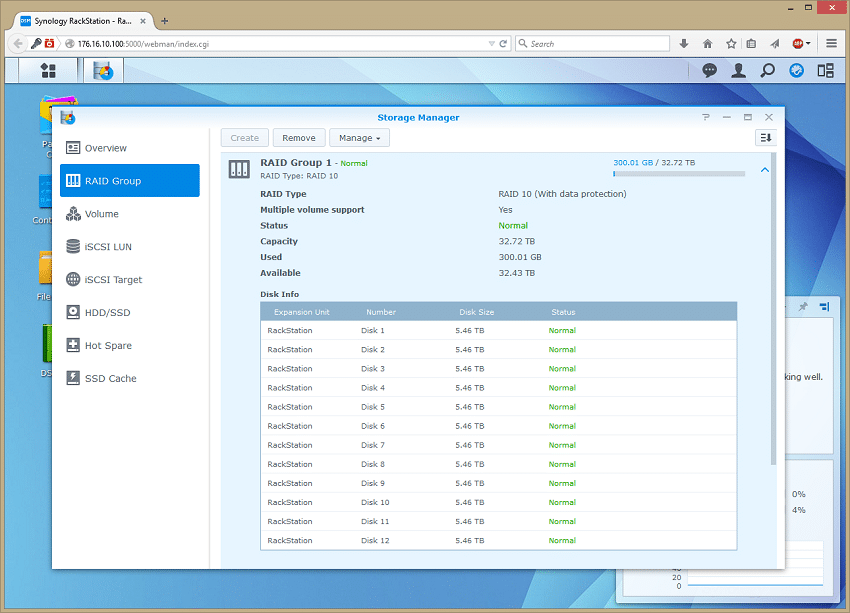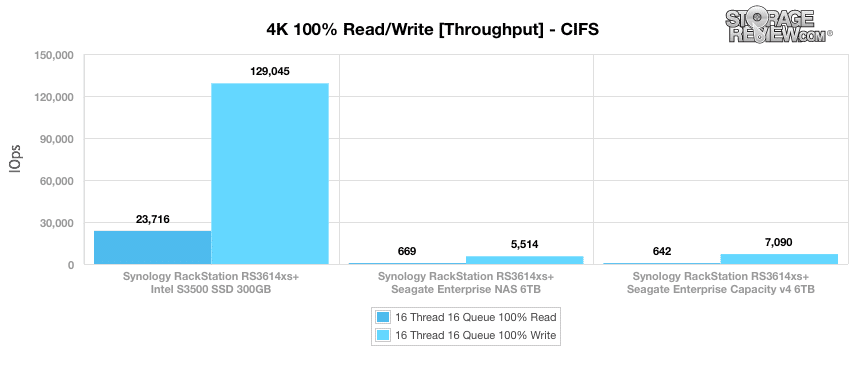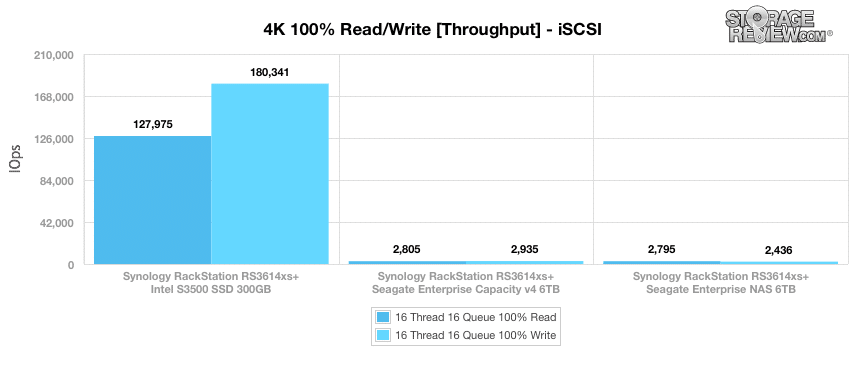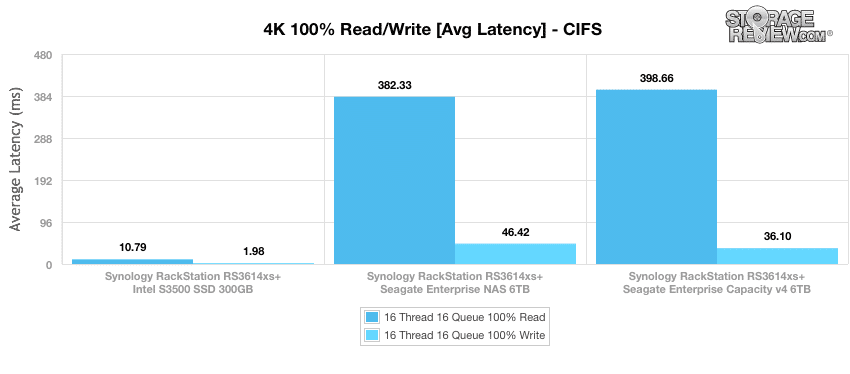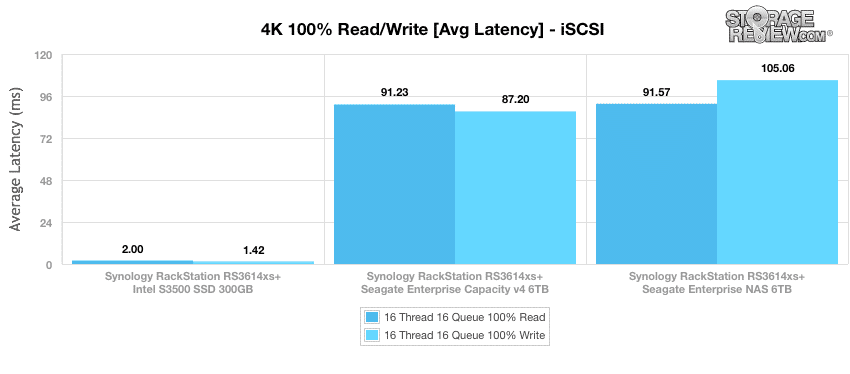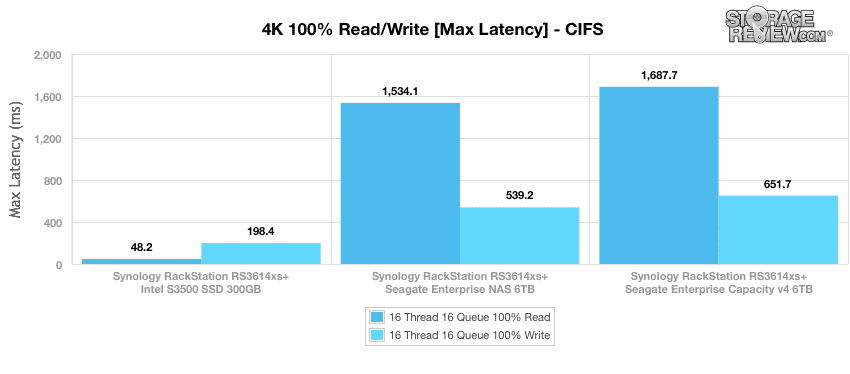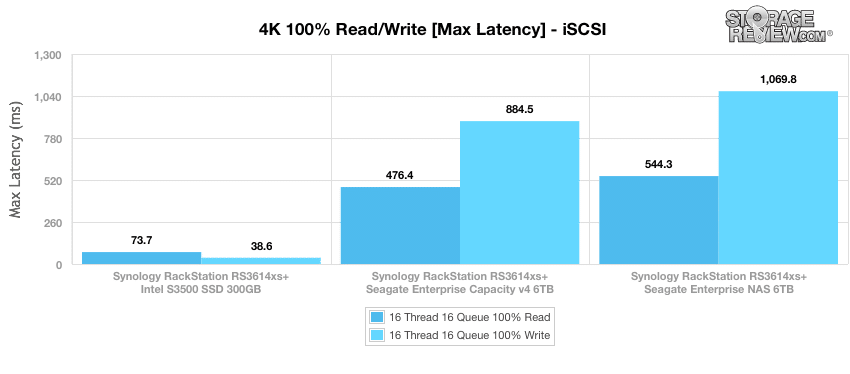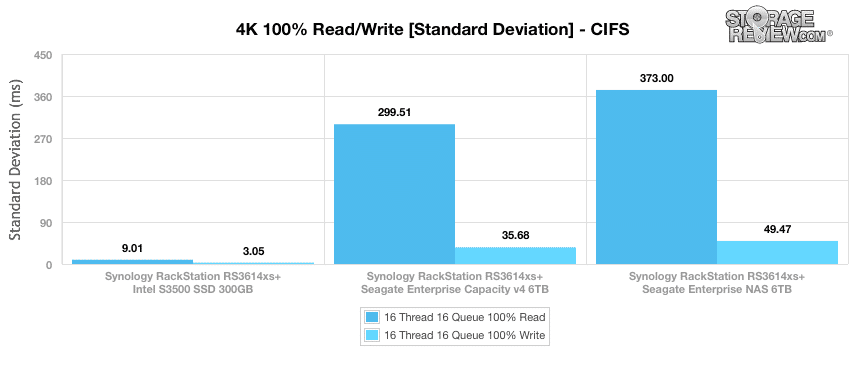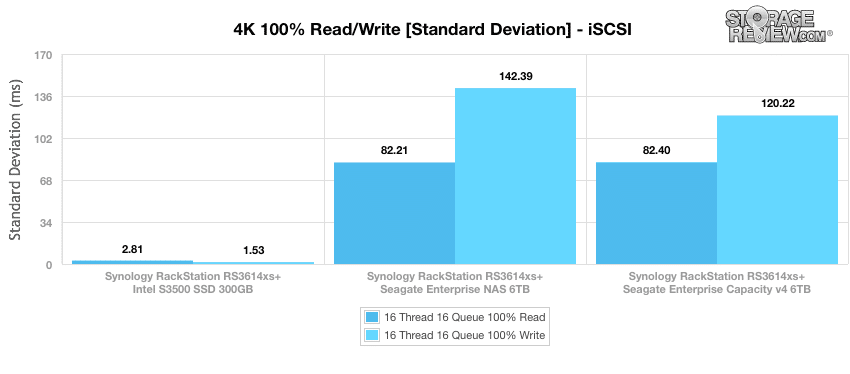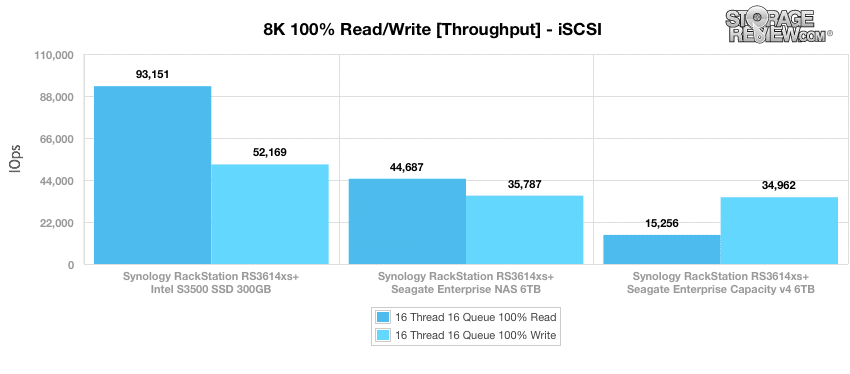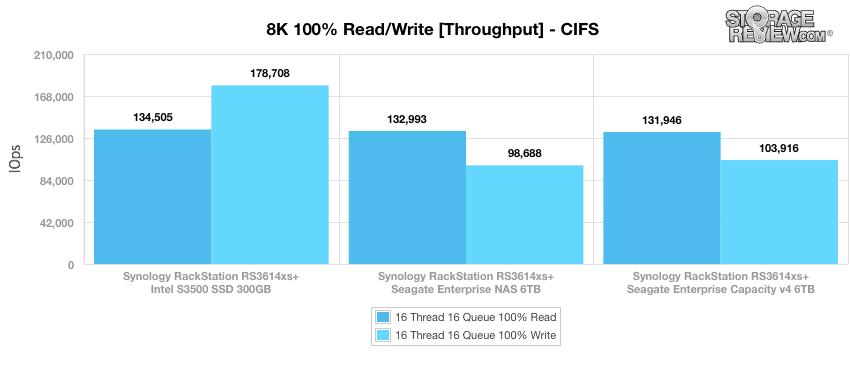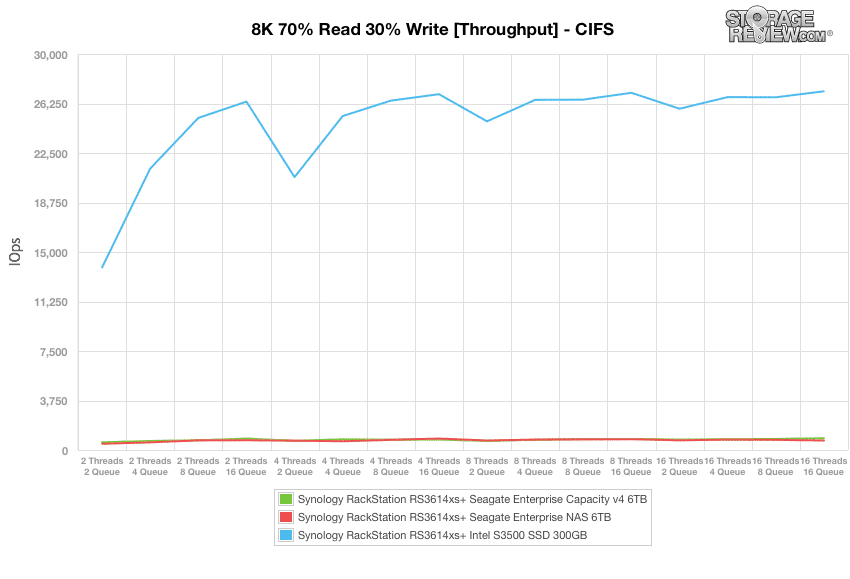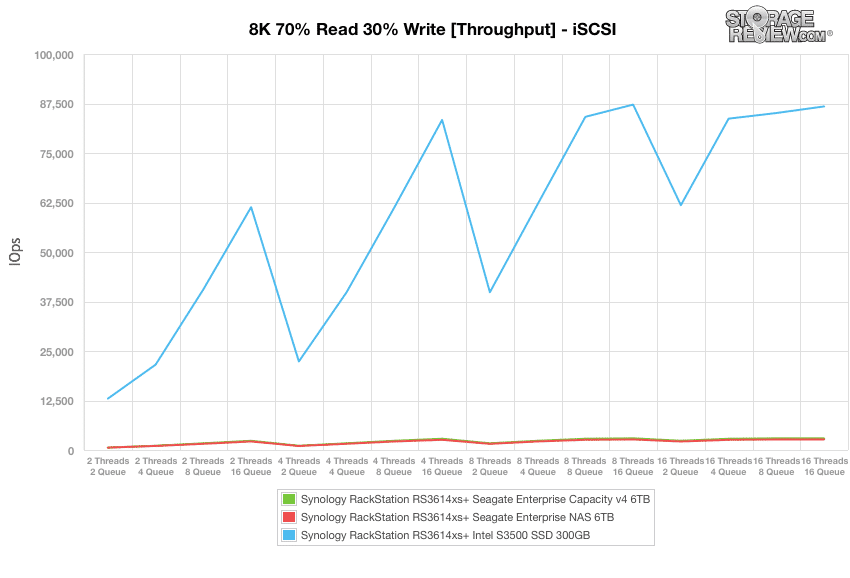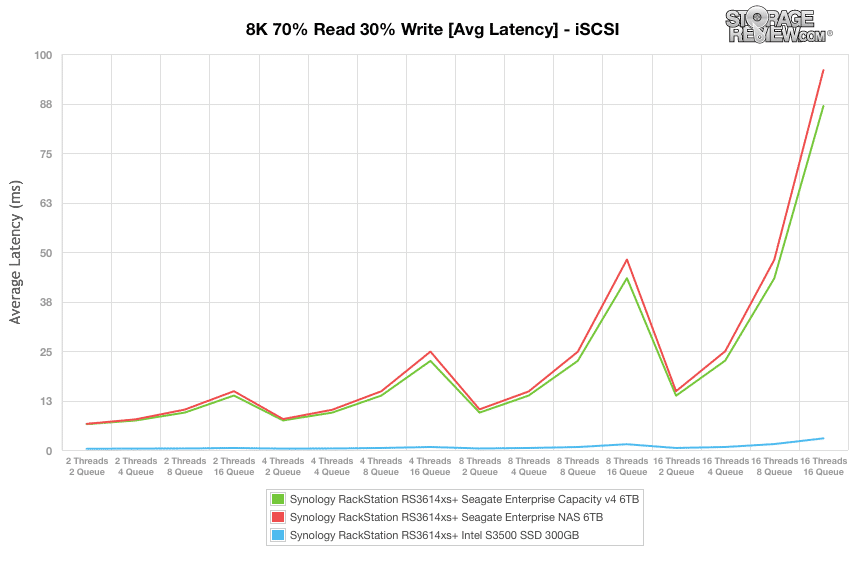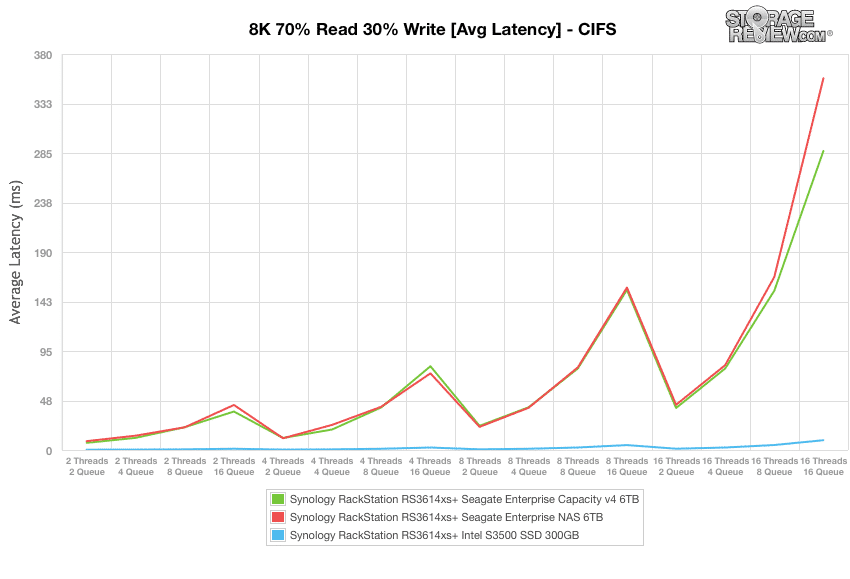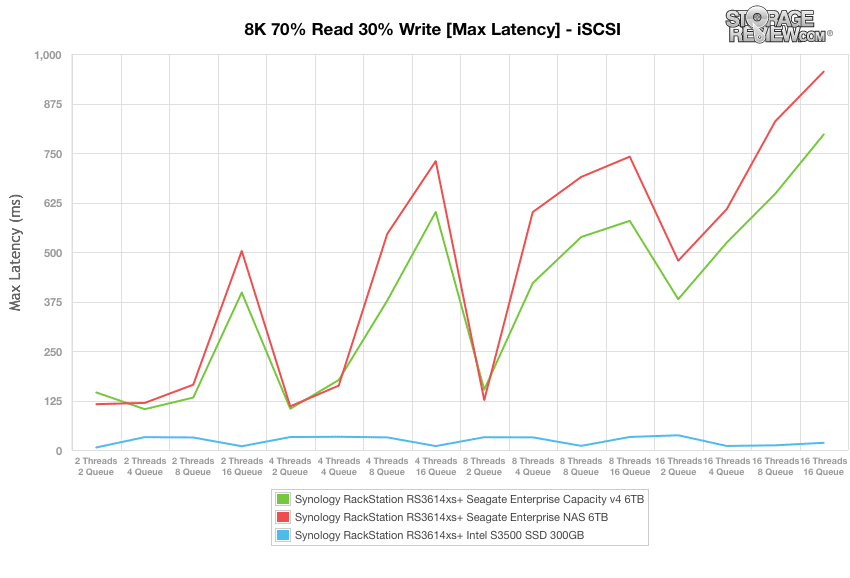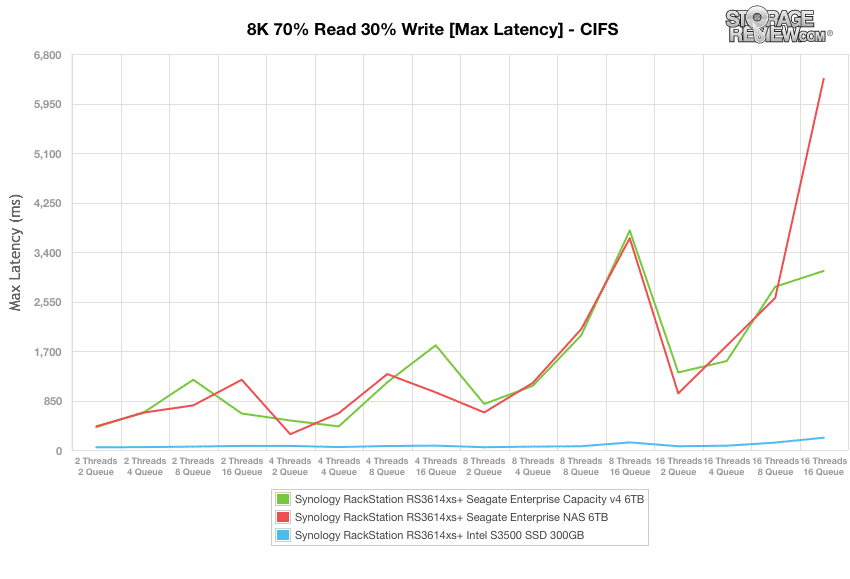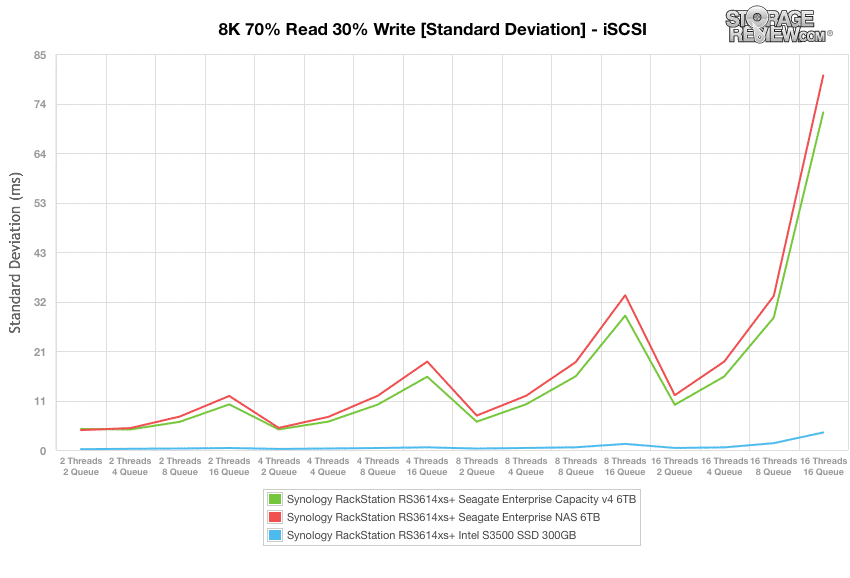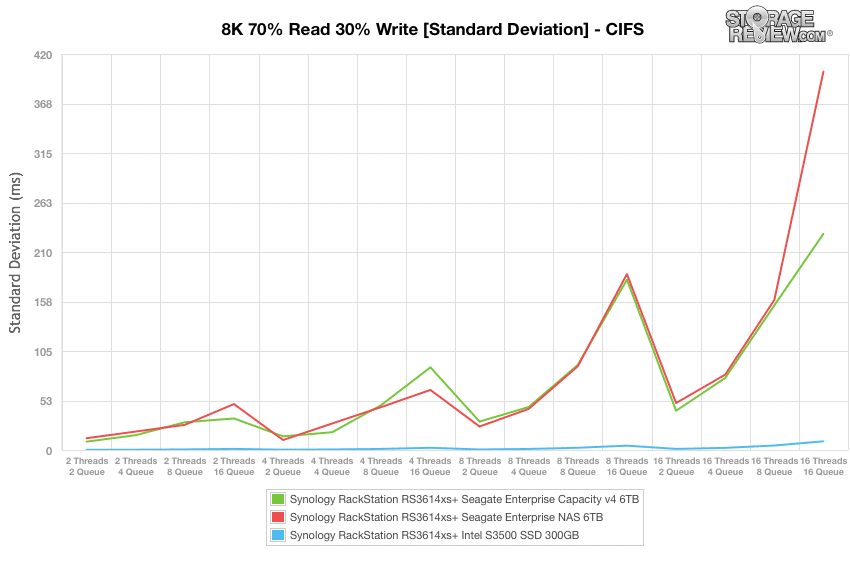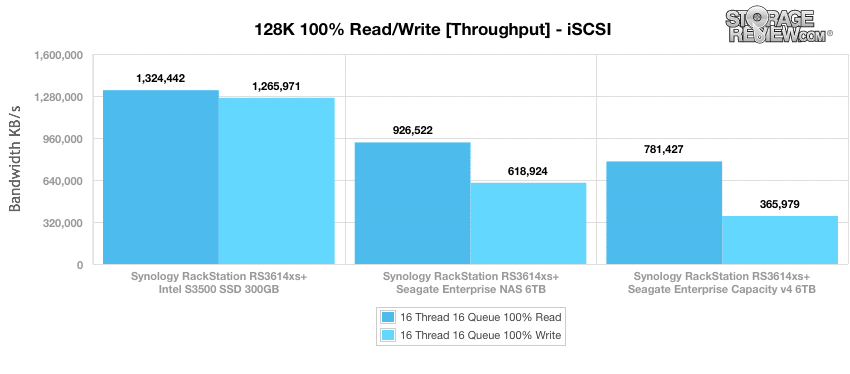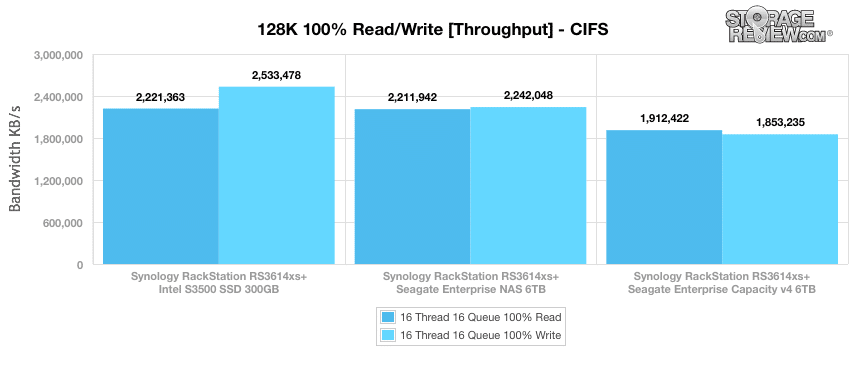
The Synology RackStation RS3614xs+ is a performance-driven network attached storage solution with 12 front-mounted hot-swappable 3.5-inch bays that is designed for businesses that require reliability and high uptime as well as a comprehensive set of business applications. Synology indicates that their RS3614xs+ simplifies data management, optimizes virtualization environments, and can rapidly expand storage capacity without having to worry about a time-consuming setup and maintenance.

Under the hood lays an Intel Xeon E3 Quad Core 3.3GHz processor with 8GB of DDR3 ECC RAM, the latter of which is expandable up to 32GB, enabling the RS3614xs+ to boast over 3,600MB/s in throughput and 439,000 IOPS. The RS3614xs+ is also scalable up to 216TB (using 36 HDDs with Synology RX1214/RX1214RP expansion units) and is equipped with dual PCIe slots for dual-port 10GbE NIC support. In addition, its SSD cache technology increases throughput in situations where the workload needs a little more performance.
Like all Synology NAS solutions, the RS3614xs+ is powered by the extensive DiskStation Manager (DSM) software and comes with applications and features that are designed explicitly for larger-scale businesses. This includes seamless integration with existing business network environments using AD and LDAP directory services without having to recreate user accounts. Additionally, with its Windows ACL support, it offers fine-grained access control with effective privilege settings, which makes the RS3614xs+ fit into current infrastructures without much hassle. The RS3614xs also features Advanced Encryption Standard (AES) on shared folders with hardware acceleration as well as continuous data protection through snapshots of shared folders.
Synology RS3614xs+ is backed by a 5-year limited warranty and carries a street price of around $4900 without disks.
Specifications
- CPU Details:
- CPU Model: Intel Xeon E3
- CPU Frequency: Quad Core 3.3GHz
- Floating Point
- Hardware Encryption Engine
- Memory
- System Memory: 8GB DDR3 ECC
- Memory Module Pre-installed: 4GB x2
- Total Memory Slots: 4
- Memory Expandable up to: 32GB (8GB x4)
- Storage
- Drive Bay(s): 12
- Max. Drive Bays with Expansion Unit: 36
- Compatible Drive Type
- 3.5″ SATA(III) / SATA(II) HDD
- 2.5″ SATA(III) / SATA(II) HDD
- 2.5″ SATA(III) / SATA(II) SSD
- Max. Internal Capacity: 72TB (6TB HDD x12) (Capacity may vary by RAID types)
- Hot Swappable Drive
- External Ports
- USB 2.0 Port: 2
- USB 3.0 Port: 2
- Expansion Port: 2
- File System
- Internal Drives: EXT4
- External Drives
- EXT4
- EXT3
- FAT
- NTFS
- HFS+
- Size (Height x Width x Depth): 88mm x 445mm x 570mm
- Weight: 15.5kg
- Other Specifications
- LAN Number (RJ45): Gigabit x4 (supports 2x optional dual-port 10GbE add-on card)
- Link Aggregation
- Wake on LAN/WAN
- System Fan: 80mm x 80mm x4 pcs
- Easy Replacement System Fan
- Wireless Support (dongle)
- Noise Level: 42.2 dB(A)
- Power Recovery
- Scheduled Power On/Off
- Power Supply Unit / Adapter: 2 X 500W
- AC Input Power Voltage: 100V to 240V AC
- Power Frequency: 50/60Hz, Single Phase
- Power Consumption: 174W (Access)
- 82W (HDD Hibernation)
- Redundant Power Supply (for xs+ and RP model)
- Temperature
- Operating Temperature: 5°C to 35°C (40°F to 95°F)
- Storage Temperature: -10°C to 70°C (15°F to 155°F)
- Relative Humidity: 5% to 95% RH
- Certification
- FCC Class A
- CE Class A
- BSMI Class A
- Warranty: 5 years
Design and Build
The Synology RackStation RS3614xs+ is a 2U rack-mounted NAS designed to meet the needs of medium to large businesses. It is equipped with 12 front-mounted hot-swappable 3.5-inch bays, which should meet Synology’s compatibility list (these include both 3.5-inch and 2.5-inch HDDs and SSDs).
The design and look of the RS3614xs+ is similar to most of the constituents of the RackStation line, which are built for reliability and ruggedness with the ability to withstand moves, installations, and general every day wear.
Apart from its 12 drive trays, the front panel is home to several LEDs including the Status (which Displays the status of the system), Alert (which displays warnings regarding fan or temperature) and Disk (which displays the status of installed drives) indicators. Also located on the front panel are the power and “beep off” buttons, the latter of which deactivates beep sounds when malfunctions occur.
The back panel of the RS3614xs+ also has a familiar Synology layout, which includes 4x LAN ports, 2x USB 2.0 ports, 2x USB 3.0 ports, expansion ports and the two PCIe expansion slots. Visible on the left side are the twin power supplies.
Inside the chassis is the Intel Xeon E3 Quad Core 3.3GHz processor with 8GB of DDR3 ECC RAM (expandable up to 32GB).
Management and Operating System
The RS3614xs+ is managed by Synology’s DiskStation Manager (DSM), Synology’s intuitive web-based operating system found on every DiskStation and RackStation. DSM offers several Synology and third party applications and features designed specifically for large-scale businesses.
The RS3614xs+ is compatible with the latest version of DSM (5.1), which has introduced peerless bidirectional sync, catering to businesses that need to share pools of data for collaborative work. In addition, files, file-types, and selected folders can be synced with another RackStation without intermediating hardware and businesses can now share common assets with Cloud Station, which is included in the DSM package. Users can download and install add-ons through the Package Center.
Testing Background and Comparables
We will be testing the Synology RackStation RS3614xs+ with the following hard drives. We will also be testing with the device with iSCSI block-level and CIFS file-level tests:
This array was benchmarked with our Lenovo ThinkServer RD630 Testbed:
- 2 x Intel Xeon E5-2690 (2.9GHz, 20MB Cache, 8-cores)
- Intel C602 Chipset
- Memory – 16GB (2 x 8GB) 1333Mhz DDR3 Registered RDIMMs
- Windows Server 2012 Standard
- Boot SSD: 100GB Micron RealSSD P400e
- Mellanox ConnectX-3 dual-port 10GbE NIC
Mellanox SX1036 10/40Gb Ethernet Switch and Hardware
- 36x 40GbE Ports (Up to 64x 10GbE Ports)
- QSFP splitter cables 40GbE to 4x10GbE
Enterprise Synthetic Workload Analysis
Our enterprise benchmark process preconditions each device into steady-state with the same workload the device will be tested with under a heavy load of 16 threads with an outstanding queue of 16 per thread, and then tested in set intervals in multiple thread/queue depth profiles to show performance under light and heavy usage. Since many shared storage platforms reach their rated performance level very quickly, we only graph out the main sections of each test.
Preconditioning and Primary Steady-State Tests:
- Throughput (Read+Write IOPS Aggregate)
- Average Latency (Read+Write Latency Averaged Together)
- Max Latency (Peak Read or Write Latency)
- Latency Standard Deviation (Read+Write Standard Deviation Averaged Together)
Our Enterprise Synthetic Workload Analysis includes four profiles based on real-world tasks. These profiles have been developed to make it easier to compare to our past benchmarks as well as widely-published values such as max 4k read and write speed and 8k 70/30, which is commonly used for enterprise drives.
- 4k
- 100% Read or 100% Write
- 100% 4k
- 8k 70/30
- 70% Read, 30% Write
- 100% 8k
- 8k (Sequential)
- 100% Read or 100% Write
- 100% 8k
- 128k (Sequential)
- 100% Read or 100% Write
- 100% 128k
In the first of our enterprise workloads, we measured a long sample of random 4k performance with 100% write and 100% read activity using the CIFS protocol. As expected, the Intel S3500 SSDs posted the best read performance and write performance (by a serious margin) measuring 23,716 IOPS and 129,045 IOPS, respectively. The Seagate Enterprise NAS and Enterprise Capacity v4 showed 669/642 IOPS read and 5,514/7,090 IOPS write.
When measuring block-level iSCSI performance of the RS3614xs+, results showed a massive gain in read throughput with the Intel S3500 SSDs with 127,975 IOPS (180,341 IOPS write). The performance of the Seagate Enterprise drives were very similar to each other, with the Enterprise Capacity v4 having the edge.
Moving to our latency segment with a load of 16T/16Q, our CIFS file-level test showed similar performance on our charts. Here, the Intel S3500 SSD showed great performance inside the Synology RackStation, with an average latency of only 10.79ms read and 1.98ms write. The Seagate Enterprise NAS drive offered lower read latency while the Enterprise Capacity drive offered lower write latency.
The iSCSI block-level test for the same benchmark showed even better results with the Intel SSDs, with 2.00ms read and 1.42ms write in average latency. The Seagate Enterprise NAS measured 91.23ms read and 87.20ms write while the Seagate Enterprise Capacity v4 measured 91.57ms read and 105.06ms write.
In our maximum 4k latency results (CIFS file-level), the RS3614xs+ showed great performance once again when populated with the Intel 3500 SSDs (48.2ms read, 198.4ms write). The Seagate Enterprise NAS posted 1,534.1ms read and 539.2ms write, while the Seagate Enterprise Capacity v4 showed 1,687.7ms read and 651.7ms write.
In iSCSI, the S3500 showed 73.7ms read and only 38.6ms write for its maximum latency. The Seagate HDDs boasted higher maximum write latency, though showed much lower read latency (compared to CIFS).
Measuring the RS3614xs+’s standard deviation for the 4k latency shows how consistent the latency results were within each of the categories during our benchmarks. Using the CIFS file-level test, the Intel S3500 SSD showed an impressive 9.01ms read and 3.05ms write, while RS3614xs+ populated with the Seagate drives showed higher performance with the Enterprise Capacity v4 HDDs.
Our iSCSI block-level test showed even better performance by the RS3614xs+ when populated with Intel S3500 SSDs (2.81ms read, 1.53ms write). The Seagate Enterprise NAS (82.21ms read, 142.39ms write) and Enterprise Capacity v4 (82.40ms, 120.22ms) posted higher write latency but improved read latency, once again, during the iSCSI block-level test.
In our next set of benchmarks, we measure 8k sequential speeds. In our iSCSI block-level test, the Intel SSD boasted great performance with 93,151 IOPS read and 52,169 IOPS write. When populated with the Seagate HDDs, the RS3614xs+ posted 44,687 IOPS read and 35,787 IOPS write (Seagate Enterprise NAS) and 15,256 IOPS read and 34,962 IOPS write (Seagate Enterprise Capacity v4).
Using the CIFS file-level test of the same benchmark, performance was improved significantly especially with the HDDs. While the RS3614xs+ populated with the Intel SSDs remained the top performer, the Seagate Enterprise drives boasted read performance almost on par with the S3500.
The next four charts are based on a protocol consisting of 70% read operations and 30% write operations with an 8k transfer size. The workload is then varied from 2 threads and a queue depth of 2 up to 16 threads and 16 queue. During our CIFS file-level test, the 8k 70/30 benchmark showed the Intel drive showed impressive performance once again, hovering around the 27K IOPS mark. As shown below, the two HDD configurations showed almost identical performance at this scale, with the Enterprise Capacity v4 taking a slight lead.
Results were mirrored during our iSCSI tests, though at a much higher performance level. Here, the Intel S3500 drive posted roughly 86,760 IOPS by 16T/16Q.
Moving to average latency, our iSCSI test showed great results for the RS3614xs+ when populated with the Intel 3500 SSDs, with an average latency of only 2.94ms by 16T/16Q. The Seagate Enterprise Capacity v4 posted 86.88ms at 16T/16Q, while the Seagate Enterprise NAS showed 95.94ms.
When looking at average latency with the CIFS block-level test, results were higher in latency. The RackStation populated with the Intel drives showed an average latency of 9.41ms by the end of our benchmark. The Seagate Enterprise Capacity v4 and Enterprise NAS posted 287.03ms and 356.72ms by 16T/16Q.
Measuring maximum latency values can sometimes reveal issues that are not always evident in our above average latency results. In iSCSI, performance results for the Intel drive configuration showed a maximum latency of only 37.18ms, which occurred at 16 Threads 2 Queue.
During our CIFS block-level test, as expected, results were a higher in latency. The Intel drive showed a max latency of 211.18ms while the Seagate Enterprise NAS posted 6,376.11ms and the Seagate Enterprise Capacity v4 reached 3,768.79ms.
Our standard deviation results for latency during our 8k 70/30 benchmark continue the pattern of performance when looking at iSCSI (file-level) for Intel S3500 SSD (211.18ms), Seagate Enterprise NAS 6TB (6,376.11ms), and Seagate Enterprise Capacity v4 (3,075.13ms) by 16T16Q.
During our file-level CIFS test, we recorded standard deviation from the Intel S3500 SSD (9.24ms), Seagate Enterprise NAS 6TB (401.37ms), and Seagate Enterprise Capacity v4 (229.34ms) by 16T16Q.
The final synthetic benchmark utilizes much larger 128k transfer sizes with sequential 100% read and 100% write operations. In this benchmark profile using iSCSI, the Intel S3500 SSD showed read activity at 1.32GB/s and write activity at 1.27GB/s. The HDD configuration fared well inside the RS3614xs+ with the Seagate Enterprise NAS showing 926,522KB/s read and 618,924KB/s write and the Seagate Enterprise Capacity v4 boasting 781,427KB/s read and 365,979KB/s write.
The CIFS test showed massive gains in both read and write speeds. As was also the case with our 8K test, the Seagate HDDs posted results almost on par with the SSD comparable.
Conclusion
Synology’s RS3614xs+ is a complete offering for SMBs and branch/remote offices with its great performance and rich feature set. Using 36 HDDs coupled with the Synology RX1214/RX1214RP expansion shelf and its 12 front-mounted hot-swappable 3.5-inch bays, the RS3614xs+ can scale up to 216TB of raw capacity. If performance is more the issue at hand, the NAS supports SSD volumes and can also leverage SSDs as a cache. Additionally, the RackStation is equipped with dual PCIe slots that support dual-port 10GbE NICs for increased throughput.
To measure the performance of the RS3614xs+, we implemented both an all-flash SSD and two HDD configurations with the Intel S3500, Seagate Enterprise NAS HDDs, and a 4th generation Seagate Enterprise Capacity HDDs. When looking at the performance of the RS3614xs+, our 4k results show how fast the platform can operate when equipped with SSDs, topping 128k IOPS read and 180k IOPS write. In our 8k random mixed workload tests, we saw strong performance as well, topping out at just under 87k IOPS from four iSCSI LUNs. Switching to 8k sequential performance tests, we measured the performance of 4 CIFS shares at over 130k IOPS for our SSD and HDD configurations alike, and around 180k write for the SSD config or 100k IOPS write for the HDDs.
Looking at large-block sequential performance in our 128k test across four 10GbE ports, we saw bandwidth from the RS3614xs+ top out at 2.5GB/s write with SSDs or 2.2GB/s with HDDs. Read bandwidth maxed out around 2.2GB/s for both SSDs and HDDs. While the platform supports two dual-port 10GbE cards for up to 4GB/s of bandwidth, in most real-world settings a single dual-port card would suffice for optimum performance.
Ultimately the Synology RS3614xs+ offers quite a bit of flexibility in a 2U rack form factor. DSM is easy to deploy and manage, offering enough features from Synology directly and via third party apps, to solve most SMB needs. With SSDs and 10GbE, the system has more upside than most will need. While not needed for most use cases, it’s nice to know it’s there should the need arise. The only real knock this system has is no support for SAS drives, but with plenty of SATA enterprise HDDs and SSDs available, that’s not a huge deal for most.
Pros
- Strong overall performance
- Excellent feature set with enough depth for most use cases
- DSM is easy to deploy and manage
Cons
- No SAS support
Bottom Line
The Synology RackStation RS3614xs+ is a 2U rack-mount NAS designed to meet the needs of the SMB or branch/remote office data center. Synology offers comprehensive software features as well as support for SSDs and optional 10GbE, which can drive well over 2GB/s read/write throughput.
Synology RackStation RS3614xs+ at Amazon

